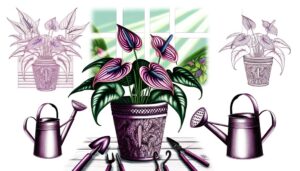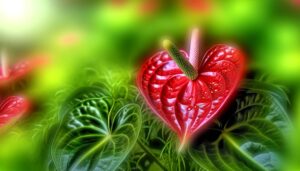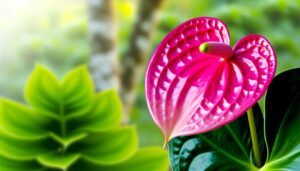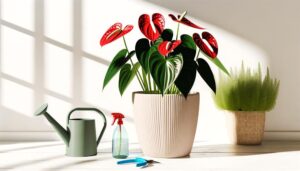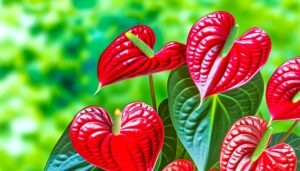What Makes the Anthurium Red Queen Unique?
The Anthurium Red Queen's uniqueness lies in its visually alluring red leaves, rich in anthocyanin pigments that provide both beauty and UV protection. Its velvety texture results from specialized epidermal cells and a trichome covering, enhancing water retention and protection.
The heart-shaped foliage is optimized for efficient photosynthesis and effective water runoff. Originating from neotropical rainforests, it exhibits remarkable adaptability and resilience.
Additionally, the Anthurium Red Queen offers air-purifying qualities by absorbing volatile organic compounds and increasing humidity. To fully appreciate its intricate cellular structure and long-lasting blooms, further exploration awaits.

Key Takeaways
- Striking red leaves with anthocyanin pigments provide vivid coloration and UV protection.
- Velvety texture from specialized epidermal cells and trichomes retains water and offers protection.
- Heart-shaped, glossy dark green foliage with pronounced venation adds aesthetic appeal and functionality.
- Efficiently filters indoor pollutants like formaldehyde and ammonia, improving air quality.
- Adaptable to varying light conditions and high indoor humidity, thriving in well-draining soil.
Striking Red Leaves
The Anthurium Red Queen's striking red leaves display a remarkable concentration of anthocyanin pigments, contributing to their vivid coloration and distinguishing them within the Anthurium genus. These pigments, mainly located in the vacuoles of leaf cells, result from complex biosynthetic pathways involving enzymes such as chalcone synthase and flavonoid 3'-hydroxylase.
Anthocyanins serve not only as visual attractants for pollinators but also as protective agents against ultraviolet radiation and oxidative stress. The chlorophyll-to-anthocyanin ratio in these leaves is carefully balanced, ensuring the best photosynthetic efficiency despite their intense pigmentation. Moreover, environmental factors such as light intensity and pH levels greatly influence anthocyanin synthesis, highlighting the adaptability and resilience of the Anthurium Red Queen in diverse habitats.
Velvety Texture
In addition to their vibrant coloration, the Anthurium Red Queen's leaves possess a velvety texture attributable to specialized epidermal cells and a dense covering of trichomes.
These epidermal cells are structured to create a microenvironment that enhances water retention and minimizes transpiration. Trichomes, tiny hair-like structures, contribute to the tactile softness and play a role in protecting the leaf surface from herbivory and excessive sunlight.
The velvety texture is not merely an aesthetic attribute but serves functional purposes such as reducing water loss and shielding the plant from environmental stressors. Research indicates that this unique texture is a result of evolutionary adaptation, optimizing the Anthurium Red Queen for survival in its native habitat.
Heart-Shaped Foliage
Characterized by its distinctive heart-shaped foliage, Anthurium Red Queen displays a unique leaf morphology that enhances both its aesthetic appeal and biological function. Each leaf is typically large, with a shiny, dark green surface that maximizes photosynthetic efficiency. The heart shape, scientifically known as cordate, facilitates efficient light capture and water runoff, reducing the risk of potential fungal infections. The venation pattern is prominent, offering structural strength and effective nutrient transport.
| Feature | Description | Function |
|---|---|---|
| Leaf Shape | Heart-shaped (cordate) | Improves light capture and water runoff |
| Surface | Glossy, dark green | Maximizes photosynthetic efficiency |
| Venation | Pronounced, reticulate | Provides structural strength, nutrient flow |
| Size | Generally large | Enhances surface area for photosynthesis |
This anatomical specialization contributes to the plant's resilience and decorative value.
Tropical Origins
The Anthurium Red Queen is indigenous to the neotropical rainforests of Central and South America, thriving in humid, shaded understories.
This species exhibits remarkable climate adaptation traits, such as its extensive aerial root system and high humidity tolerance, which facilitate nutrient acquisition and moisture retention.
Ecologically, the Anthurium Red Queen plays a pivotal role in its native habitat, contributing to the biodiversity and stability of the forest floor ecosystems.
Native Habitat Insights
Originating from the lush tropical rainforests of Central and South America, Anthurium Red Queen thrives in the humid, shaded understories where it benefits from the consistent warmth and moisture. This species is adapted to the dimly lit, nutrient-rich environments of the forest floor, which provide a stable microclimate conducive to its growth. The plant's broad, glossy leaves serve a significant role in maximizing photosynthesis under low light conditions. Moreover, the high humidity levels support its epiphytic nature, allowing it to absorb water and nutrients efficiently.
| Aspect | Description |
|---|---|
| Native Regions | Central and South America |
| Preferred Light Levels | Low to moderate, indirect sunlight |
| Humidity Requirements | High (70-90%) |
| Soil Composition | Well-draining, rich in organic matter |
Understanding these habitat specifics is vital for replicating the best growing conditions.
Climate Adaptation Traits
Leveraging its tropical origins, Anthurium Red Queen exhibits several climate adaptation traits that allow it to thrive in environments characterized by high humidity and consistent warmth.
This perennial plant demonstrates remarkable physiological and morphological adaptations, such as large, waxy leaves that minimize water loss via transpiration. Its extensive root system is adapted for both epiphytic and terrestrial growth, maximizing nutrient and moisture absorption.
Additionally, the Anthurium Red Queen has evolved to optimize photosynthesis under low light conditions, typical of dense tropical canopies. Research indicates that its stomatal regulation is finely tuned to prevent desiccation while maintaining gas exchange efficiency.
These traits collectively ensure the Anthurium Red Queen's resilience and vigor within its native tropical habitats and similar cultivated environments.
Ecological Significance
Anthurium Red Queen plays an essential role in its tropical ecosystems, contributing to biodiversity and facilitating intricate plant-animal interactions through its vibrant flowers and foliage. Originating from the dense understory of tropical rainforests, this species exhibits specialized adaptations that enhance its ecological niche.
Its striking red spathes and glossy leaves are not merely aesthetic; they function as attractants for pollinators such as beetles and butterflies. These interactions are important for the plant's reproductive success and genetic diversity. Additionally, the plant's structure provides microhabitats for various invertebrates, promoting a complex web of life.
The Anthurium Red Queen's presence therefore strengthens ecosystem resilience, demonstrating its indispensable role in maintaining the ecological balance of tropical environments.
Regal Appearance
With its striking red spathes and lush green foliage, the Anthurium Red Queen exudes a regal appearance that captivates both botanists and horticultural enthusiasts alike. The vibrant spathes are not merely ornamental but serve essential biological functions.
Detailed analysis reveals three key attributes:
- Chromatic Intensity: The deep red pigmentation, attributable to anthocyanin compounds, aids in pollinator attraction.
- Foliage Morphology: The broad, heart-shaped leaves maximize photosynthetic efficiency, contributing to robust growth.
- Structural Elegance: The upright, sturdy stems provide architectural stability, enhancing its visual appeal.
These features collectively underscore the Anthurium Red Queen's distinctive aesthetic and biological sophistication, making it a subject of considerable interest in botanical research and ornamental horticulture.
Low-Maintenance Care
Despite its regal appearance, the Anthurium Red Queen is remarkably low-maintenance, requiring minimal intervention to thrive in both residential and professional environments.
This tropical perennial plant benefits from well-draining soil, ideally a mix of orchid bark, perlite, and peat moss, which mimics its native epiphytic conditions. Best growth occurs in indirect sunlight; direct exposure may cause foliar damage.
Watering should be moderate, allowing the top inch of soil to dry between sessions to prevent root rot. Humidity levels above 60% are preferable, though the plant can adapt to lower levels.
Fertilization with a balanced, water-soluble fertilizer every six to eight weeks during the growing season enhances essential. Regular pruning of spent flowers and yellowing leaves promotes sustained health and aesthetics.
Air-Purifying Qualities
The Anthurium Red Queen exhibits remarkable air-purifying qualities, effectively removing common indoor pollutants such as formaldehyde, ammonia, and xylene.
Research indicates that its broad, waxy leaves play a vital role in filtering out these volatile organic compounds, thereby enhancing indoor air quality.
Removes Indoor Pollutants
Effectively reducing indoor air pollutants, Anthurium Red Queen demonstrates significant air-purifying qualities through its ability to absorb and break down volatile organic compounds (VOCs).
Research has shown that this plant is capable of mitigating several common indoor pollutants, which include:
- Formaldehyde: Often found in household items such as furniture and cleaning agents, formaldehyde is a known irritant.
- Ammonia: Emitted from various household products, ammonia can be harmful when inhaled over prolonged periods.
- Xylene and Toluene: Present in paint and adhesives, these chemicals are linked to respiratory issues.
The Anthurium Red Queen's unique physiology enables it to perform phytoremediation, contributing to a healthier indoor environment by systematically reducing these hazardous compounds.
Improves Air Quality
Utilizing its robust phytoremediation capabilities, the Anthurium Red Queen greatly enhances indoor air quality by systematically filtering out harmful airborne contaminants. This plant species excels in absorbing volatile organic compounds (VOCs) such as formaldehyde, benzene, and xylene through its stomata during photosynthesis.
Scientific studies have demonstrated that the Anthurium Red Queen's extensive root system and large, glossy leaves facilitate the uptake and breakdown of these pollutants, converting them into less harmful substances. Additionally, the plant's high transpiration rate contributes to increased humidity levels, mitigating respiratory irritants and promoting a healthier indoor environment.
Through these mechanisms, the Anthurium Red Queen serves not only as an aesthetic centerpiece but also as an essential component in maintaining cleaner, safer air quality.
Long-Lasting Blooms
Renowned for its exceptional long-lasting quality, the Anthurium Red Queen displays blooms that can persist for several months under ideal conditions. This extended bloom period is linked to various botanical and environmental factors.
- Cellular Structure: The plant's sturdy cellular architecture facilitates sustained nutrient transport, maintaining bloom strength.
- Optimal Growing Conditions: Maintaining a stable environment with controlled humidity, temperature, and light intensity supports prolonged flower life.
- Nutrient Absorption: Efficient nutrient uptake from the soil ensures that the plant remains healthy and capable of supporting enduring blooms.
Research indicates that the combination of these factors greatly enhances the Anthurium Red Queen's bloom durability. Such long-lasting quality not only adds aesthetic value but also highlights the plant's resilience, making it a preferred choice among horticultural enthusiasts.
Indoor Adaptability
Given its remarkable bloom longevity, the Anthurium Red Queen also exhibits a high degree of indoor adaptability, making it an ideal plant for interior environments.
Its physiological resilience allows it to thrive in varying light conditions, from low to moderate indirect light, reducing the photoinhibition risks.
The Anthurium Red Queen's best growth is facilitated by its efficient use of water and nutrient uptake, requiring a well-draining soil medium to prevent root rot.
Moreover, its tolerance to average indoor humidity levels (40-60%) minimizes the necessity for specialized microclimates.
Research has demonstrated that this species can maintain robust foliar health and vibrant coloration even in controlled indoor settings, highlighting its suitability for aesthetic and functional roles in interior plant design.
Symbolism and Meaning
The Anthurium Red Queen, with its striking red spathes and lush green foliage, carries rich symbolic meanings associated with love, passion, and essentiality. This plant's vivid coloration and robust appearance make it a compelling subject for symbolic interpretation.
Love: The deep red hue of the spathes represents profound affection and emotional depth, often associated with romantic love.
Passion: The vibrant red tones signify intense passion and energy, reflecting the plant's tropical origins and dynamic growth patterns.
Essentiality: The enduring green foliage symbolizes stability and sustenance, indicative of the plant's resilience and longevity.
These symbolic attributes are not merely ornamental but are rooted in cultural and historical contexts, enhancing the Anthurium Red Queen's appeal in various settings.
Decorating Tips
When considering Anthurium Red Queen for interior decoration, its vibrant red spathes serve as bold color accents that can enhance visual appeal in various settings.
This plant's morphological characteristics allow for versatile placement options, ranging from standalone centerpieces to integrated components in mixed floral arrangements.
Research indicates that incorporating such striking elements can greatly influence the aesthetic dynamics of both residential and commercial spaces.
Bold Color Accents
Strategically incorporating Anthurium Red Queen plants into interior decor can effectively introduce bold color accents, enhancing both visual interest and spatial dynamics. The vibrant red spathes of the Anthurium Red Queen provide striking visual contrast, which can be leveraged in various ways:
- Focal Points: Positioning these plants in central locations, such as coffee tables or entryways, draws immediate attention and serves as a visual anchor.
- Color Harmony: Pairing with neutral or monochromatic palettes magnifies the intensity of the red hues, creating a balanced yet eye-catching aesthetic.
- Textural Contrast: Integrating the glossy, heart-shaped leaves alongside matte or soft-textured furnishings highlights the plant's unique morphology.
These techniques are substantiated by principles of color theory and interior design, ensuring a refined and sophisticated ambiance.
Versatile Placement Options
In addition to serving as bold color accents, Anthurium Red Queen plants offer versatile placement options that can optimize spatial utilization and enhance interior design schemes.
Their adaptability to varied light conditions—ranging from indirect sunlight to low-light environments—enables placement in diverse spatial contexts, such as office desks, living room corners, and bathroom shelves.
Research indicates that Anthuriums thrive in well-draining soil and moderate humidity, making them suitable for both residential and commercial settings.
Moreover, their compact root systems allow for innovative container choices, including hanging baskets and wall-mounted planters.
Conclusion
The Anthurium Red Queen is a paragon of botanical splendor with its striking red leaves, velvety texture, and heart-shaped foliage. Originating from tropical regions, its regal appearance and long-lasting blooms captivate the observer's gaze. Its remarkable indoor adaptability further enhances its allure.
However, what truly elevates this plant to a domain of fascination is its profound symbolism and meaning. What deeper significance does this enigmatic plant hold? The answers continue to intrigue and beckon further exploration.

